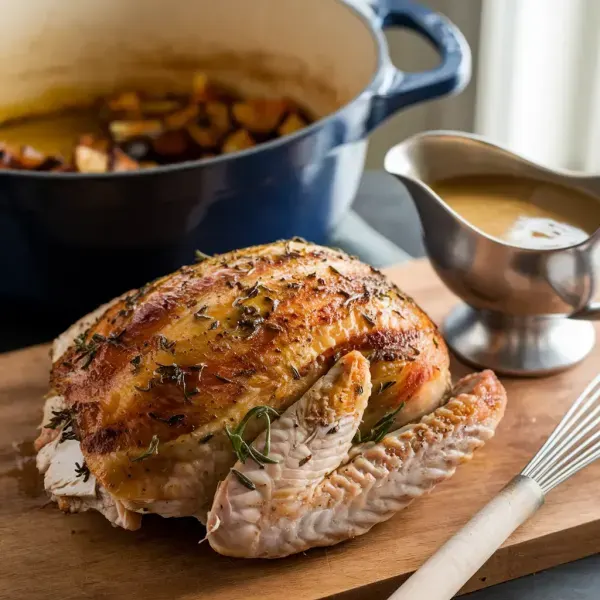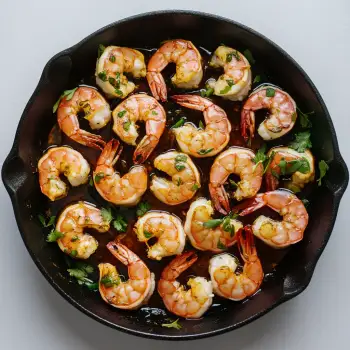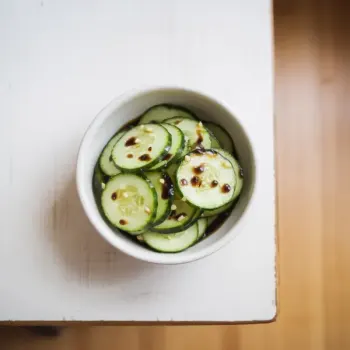
 180 minutes
180 minutesA delicious herb-roasted turkey breast paired with a rich and flavorful classic pan gravy.


Turkey Breast, Bone-In
0 lb
to taste
to taste
tablespoons
Onion, chopped medium
each
Carrot, chopped medium
each
Celery Rib, chopped medium
each
Garlic Clove, peeled and crushed
each
sprigs
Bay Leaf
each
Unbleached All-Purpose Flour
cups
Low-Sodium Chicken Broth
cups
1. Preparation
Start by adjusting the oven rack to the lower-middle position and preheating the oven to 325 degrees Fahrenheit. Trim any excess fat from the turkey breast, then pat it dry with paper towels. Season the turkey generously with salt and pepper, ensuring even coverage for optimal flavor absorption.
2. Browning
In a large Dutch oven, heat the olive oil over medium-high heat until shimmering. Place the turkey breast side down in the pot and scatter the chopped onion, carrot, celery, crushed garlic cloves, fresh thyme, and bay leaf around it. Allow the turkey to brown on one side for about 12 to 16 minutes, turning it over and stirring the vegetables occasionally, until both the turkey and vegetables are well browned.
3. Oven Cooking
Once browned, remove the pot from heat. Cover the pot with a large sheet of foil and then place the lid on top. Transfer the pot to the preheated oven and cook for 1.5 to 1.75 hours, or until the thickest part of the turkey breast registers between 160 to 165 degrees Fahrenheit on an instant-read thermometer.
4. Resting
Remove the pot from the oven and transfer the turkey breast to a cutting board. Tent the turkey loosely with foil and let it rest while you prepare the gravy.
5. Gravy Preparation
Place the pot with the remaining juices and vegetables over medium-high heat on the stovetop. Simmer until the liquid has mostly evaporated, which should take about 15 to 20 minutes. Stir in the flour and cook for another 2 to 5 minutes, until the flour is browned and has absorbed the juices. Gradually whisk in the chicken broth, ensuring no lumps form, and bring the mixture to a simmer. Continue to cook for 10 to 15 minutes, or until the gravy has thickened and reduced to about 2.5 cups.
6. Straining and Serving
Strain the gravy through a fine-mesh strainer into a serving bowl, pressing on the solids to extract as much liquid as possible. Season the gravy with salt and pepper to taste. Carve the rested turkey breast into slices and serve it alongside the warm, flavorful gravy.
Use lemon zest and thyme in herb rub and add fresh lemon juice to the gravy.
Brush on a honey and balsamic glaze for a caramelized finish.
Use a sage rub for pork loin and deglaze with apple cider for gravy.
Add lemon zest and garlic into the herb rub for zestiness and savoriness.
Sauté mushrooms and add to gravy for umami depth.
Use a reliable meat thermometer to check the internal temperature of the turkey. Overcooked turkey is dry turkey. Aim for 165°F (74°C) at the thickest part of the breast. Remember that the temperature will continue to rise a few degrees after you take it out of the oven (carryover cooking).
For an extra moist and flavorful turkey breast, consider brining it for several hours or overnight. A simple brine can be made with water, salt, sugar, and some of your chosen herbs.
Allow the turkey to rest for at least 15-20 minutes after removing it from the oven. This lets the juices redistribute, ensuring a moist turkey breast when sliced.
Elevate the flavor by mixing your chosen herbs into softened butter and gently working it underneath the skin of the turkey breast. This will help the meat stay moist and infuse it with herbaceous notes as it cooks.
When making the classic pan gravy, deglaze the roasting pan with a good quality stock, scraping all the bits off the bottom of the pan. This is where the flavor is. Consider using wine or spirits that complement your herb profile for an added depth of flavor.




Comments (0)